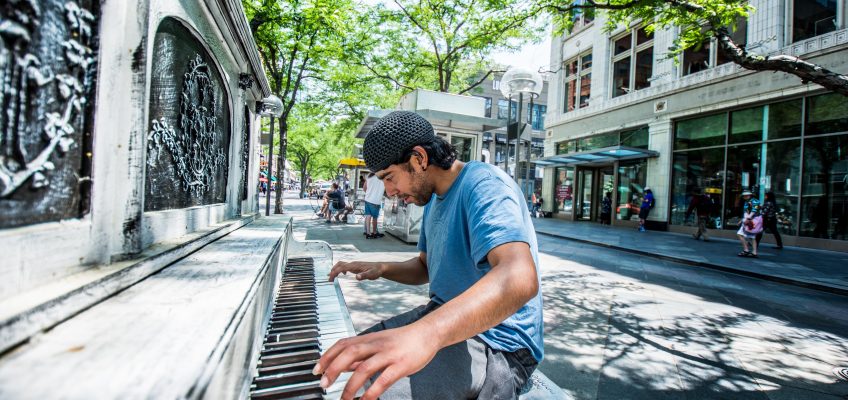When we gather for Mass on Sunday, the church expects a high standard of celebration:
In the earthly liturgy we take part in a foretaste of that heavenly liturgy which is celebrated in the holy city of Jerusalem toward which we journey as pilgrims, where Christ is sitting at the right hand of God, a minister of the holies and of the true tabernacle; we sing a hymn to the Lord’s glory with all the warriors of the heavenly army; venerating the memory of the saints, we hope for some part and fellowship with them; we eagerly await the Savior, Our Lord Jesus Christ, until He, our life, shall appear and we too will appear with Him in glory. (Constitution on the Sacred Liturgy, 8)
Liturgical leaders, especially liturgical musicians, are charged with guiding us in worship that helps us imagine we are singing with the heavenly army as we eagerly await the Savior. As we said in a previous post, this mission goes way beyond just picking songs. It is a work of art.
What does the church consider to be “art”?
As soon as we say “art,” however, I can feel confidence fading and attention wandering. Few of us would call ourselves artists. We think of artists as rare geniuses who have been given a unique insight into the mystery of life. They descend from their studios to bless us with an image, a song, a poem — an oeuvre — that is meant to reveal that which most of us cannot know except through the mediation of the artist.
There is art like that and artists like that, but that is not at all what the church means by art.
The first and only creator is God, who brought something out of nothing. Pope John Paul II said, in the strict sense, only God can do this. The human artist is not strictly a “creator” but a “craftsperson.”
God therefore called man into existence, committing to him the craftsman’s task. Through his “artistic creativity” man appears more than ever “in the image of God,” and he accomplishes this task above all in shaping the wondrous “material” of his own humanity and then exercising creative dominion over the universe which surrounds him. (Letter to Artists, 1)
While not all of us are called to the vocation of artist in the specific sense, “all men and women are entrusted with the task of crafting their own life: in a certain sense, they are to make of it a work of art, a masterpiece” (2).
If you are a liturgical musician, you have an especially challenging task. You are not an artist in the sense of a composer or a performer (though you may do those things). And the masterpiece you must create is not simply the crafting of your own life.
The mission of the liturgical musician (and all liturgical leaders) is to receive a sacred script and animate that story by orchestrating and maximizing the motley, disparate gifts of whoever shows up for Mass next Sunday.
Agree and say “Yes!”
This means the skill you must rely on most cannot be your instrument or your conducting style or your knowledge of music theory. It has to be improvisation. And that means you have to figure out how to say “yes.” Master improv artist Tina Fey writes:
The first rule of improvisation is AGREE. Always agree and SAY YES. When you’re improvising, this means you are required to agree with whatever your partner has created. So if we’re improvising and I say, “Freeze, I have a gun,” and you say, “That’s not a gun. It’s your finger. You’re pointing your finger at me,” our improvised scene has ground to a halt. But if I say, “Freeze, I have a gun!” and you say, “The gun I gave you for Christmas! You bastard!” then we have started a scene because we have AGREED that my finger is in fact a Christmas gun. (Bossypants)
When the assembly shows up late, won’t open their hymnals, won’t join in the opening song, won’t respond to the responsorial, won’t sing joyfully as they approach the Lord’s table, you have to find a way to not say, “why won’t you?” or “you should.” That’s the same as saying, “That’s not a gun. It’s your finger.”
Instead you have to find a way to say “Yes, and….” By their behavior, the assembly says, “We’re late.” And you say, “How wonderful that we are together now!” The assembly says, “We won’t sing that song.” And you say, “Yes, that song is hard to sing, and we have another that’s more singable!”
To successfully craft the liturgy — to be a true liturgical artist — you have to use the materials you are given to share in God’s creative power and make something beautiful. Share on XThe secret here is that you don’t have to agree in your heart. You can be judgmental and dismissive all you want in the depths of your soul. (I’ll leave it to you to decide if you need to go to confession for that!)
But to successfully craft the liturgy — to be a true liturgical artist in the sense that Pope John Paul II is calling all of us to make a work of art — you have to use the materials you are given to share in God’s creative power and make something beautiful.
Yes, you’re right. It’s hard work. Darn near impossible. Not everyone can do it. And you can. And because you can, we are all going to “appear with [Christ] in glory.” How cool is that?



Leave a Reply